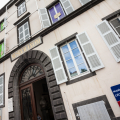The Henri Lecoq Museum, which has been awarded the "Musée de France" label, has nearly 650,000 objects and specimens on display in five scientific departments.
History of science and technology department
The museum's collections trace the history of science and technology from the 16th to the 21st century through renowned scientists and instruments.
It preserves and enriches a collection of mechanical calculating machines in connection with two originals of Blaise Pascal's calculating machine.
The collections of scientists are preserved in order to transmit their memory and their work. This heritage includes their writings and laboratory equipment, such as Louis Pasteur's balloon, which bears witness to his time in Clermont-Ferrand. Local and contemporary scientists are honoured, such as Professor Philippe L'Héritier, a famous geneticist.
It preserves and promotes the exceptional collection of the chemist Antoine-Laurent de Lavoisier (3200 items), most of which are mineralogical in nature. Through this department, the museum participates in the national mission to safeguard contemporary scientific and technical heritage (PATSTEC) and the network of museums and technical collections (Rémut).
The Department of Written and Graphic Heritage
Old books, archives and iconographic documents make up this collection. It includes all the works written by Henri Lecoq, those in his library, and works dating from before 1810, such as the Atlas minéralogique de la France by Guettard and Lavoisier (1778).
Notes and photographs, old inventories and manuscripts make up the scientific archives. They come from regional scientists and/or those linked to the museum, including the geologists Philippe Glangeaud, Louis Glangeaud and Alain de Goër, the botanist Maurice Chassagne and the geneticist Philippe L'Héritier.
The iconographic documents include geological maps published by Lecoq, posters advertising his famous sweet acorn coffee, and watercolour plates of mushrooms produced under the direction of Martial Lamotte.
In addition, more than 14,000 books make up the museum's rich scientific library.
The Botany Department
Herbariums are collections of dry plants preserved between sheets of paper. Protected in this way, the plants survive the years and sometimes end up in museum reserves. This is the case at the museum where the botanical collections originate from Henri Lecoq's very rich herbarium to which, over the years, plates by famous botanists such as Brévière, Jordan de Puyfol and frère Anthelme or less famous ones such as Jelenc and Combaret have been added. Each plate has a label mentioning the scientific name, the date and the place of harvest.
True scientific archives, the herbaria contain information on the flora of the Massif Central and a large part of Europe, from 1790 to the present day. They contain all the representatives of the plant kingdom, from the modest moss to the imposing oak, not forgetting the algae and ferns. Lichens and mushrooms are also included by tradition.
The herbaria are completed by series of seeds and fruits as well as plaster specimens.
Geology Department
Geology is represented by a department that preserves nearly 50,000 samples of rocks, minerals and fossils.
Whether they were collected by scientists (Henri Lecoq, Lavoisier, Romme) to be studied in order to better understand the formation of the Earth and its evolution, or by amateurs (Jacques des Forest, Eric Naud, and many others), these specimens form the archives of our planet, whose chronicles they record; witnesses and actors of the events that have made the history of the Earth over time. The role of the museum, in addition to conserving and preserving these fragments of history for future generations, is to make them available to the public through exhibitions and to scientists for study, so that knowledge can spread and advance.
Department of Zoology
The vertebrate collections, mainly of regional and worldwide origin, are mainly made up of the Henri-Lecoq collections: 700 naturalized mammals and osteological specimens, 2,400 naturalized birds, 2,700 birds' eggs and nests, 700 fish, amphibians and reptiles preserved in liquid.
The entomological collections include 290,000 insects (mainly Lepidoptera and Coleoptera). Representative of the regional fauna, they are reference collections. The collections were made from the end of the 19th century.
The Mollusc collections include 120,000 marine, terrestrial and freshwater shells of regional and worldwide origin. Most of them come from the museum's old collections. They are reference series, with types and figures.
LEGAL NOTICES





L'expo temporaire était plutôt moyenne avec beaucoup trop de spécimens en plastique malgré tout, le côté interactif et ludique à sauvé les meubles !